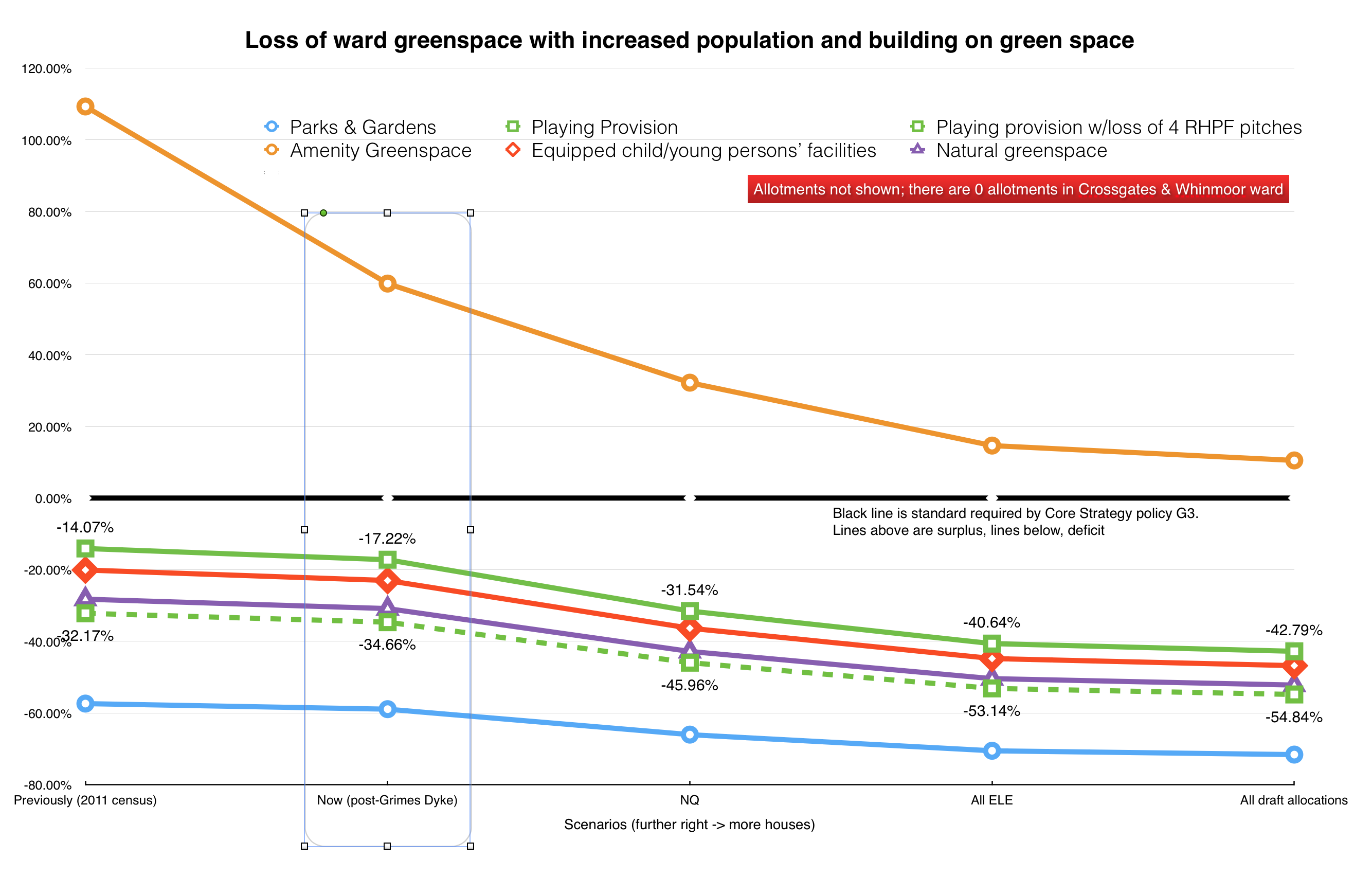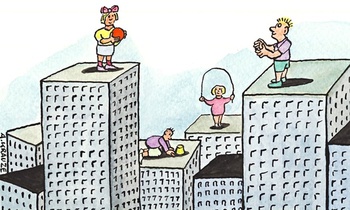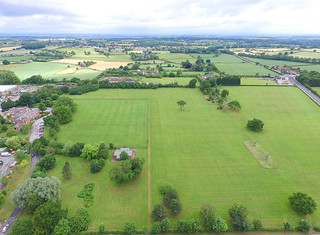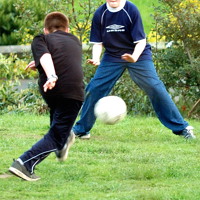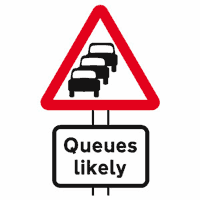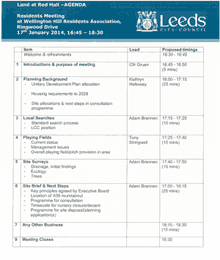 Agenda (PDF Download)
Agenda (PDF Download)
Last night (17th Jan 2014), 40-50 people turned out to meet with our ward councillors in a packed Wellington Hill Residents’ Association room. Cllr Debra Coupar was not in attendance, but deputy leader Cllr Peter Gruen and Cllr Pauleen Grahame were, along with several members of planning and policy teams:
- Kathryn Holloway
- Tony Stringwell
- Andrew Crates
- Adam Brannen
There were apologies from people who couldn’t make the 4.45pm start time. It was probably as well that more could not attend, as the WHRA room was full to capacity. Thank you to the WHRA for allowing this meeting to be held at their premises.
These are not minutes. This is a picture of events taken from hastily-scribbled notes while trying to listen and participate. It will be necessarily incomplete.
The agenda
The councillors set the agenda. This was mostly adhered to, although some points were addressed out of order.
Main points of concern for residents
Loss of the fields
The message from our councillors with respect to the fields seems somewhat mixed. We received these messages last night:
- “There are no plans yet for the fields”
- “everybody knows the council is strapped for cash”
- “we cannot simply object to planning applications, as it will go to appeal, and the council will lose”
- “The fields have been planned for development for a long time”
Given these, I raised the following: Red Hall playing fields are currently in public hands. We will not have a problem with planning appeals when no developer owns the land in the first place.
Cllr Gruen’s response to that was: “That debate is yet to be had”.
When we attempt to discuss the fields, we are repeatedly told “There are no plans yet for the fields” and “You will be consulted about any plans for the fields”. Unless I have missed something – and I am prepared to be corrected on this – it seems plain that we are being asked to refrain from commenting on the eventual fate of the fields until such time as a capital receipt for them has been safely banked and their future is out of public hands and in the hands of developers.
(The aforementioned agenda, on p25, Item 6, states “Council to start formal marketing of the Red Hall site” in 2015 )
Here are our messages to Leeds City council. We hope they are not mixed:
“Don’t sell the fields.”
This was explicitly and unequivocally vocalised last evening on more than one occasion. The fields are much in use as a safe, visible and valuable meeting place, a place for informal exercise and play, and at peak times, an overflow for Roundhay Park. They are within walking distance of existing and future residents. Most importantly, unlike the proposed Whinmoor Grange site, they are not miles away from their users on the east periphery of Leeds and on the other side of a dual carriageway.
Playing fields are uniquely valuable in that they serve a dual purpose: formal sports provision and informal green space. At present, due to the drainage issues, they can only reasonably be used (outside of dry spring and summer weather, at any rate) as informal green space.
“We would like to register the fields as a Local Green Space”
Cllr Gruen said this was “a big ask”. When asked why, he said that we were intelligent people who should all be aware that Leeds City Council is “strapped for cash”. On the one hand, there “are no plans for the fields”. On the other, then, they are going to be sold.
We wish to protect these fields as a green space.
We very much hope we can explore the option of such registration further with Leeds City Council.
Failure of LCC to properly consult on site allocation
Despite a two-month site allocation consultation undertaken in 2013, many residents (both during and after the meeting) expressed shock that they were unaware of such a large and important process. Despite an advertising campaign involving radio, bus advertising, signs in Golden Acre Park and library information, people at the meeting (who cared enough to give up the early part of their Friday evening) were not aware they could have had a say that would have had some effect as early as last summer. A marketing manager in attendance said he “would [have been] sacked” if he had failed to reach his target audience in this way.
There was not time to make the point I wanted to make about that consultation last night, but here it is from a personal perspective: I work from home. When I take buses I tend to be sitting in them reading a book, not reading adverts, my nearest library is over two miles away and not reasonably walkable, and the radio stations chosen (Radio Aire, Magic FM) are not stations I (or indeed many residents) would choose to listen to. The adverts themselves said “Your city, your say”. One of the planning team in attendance expressed the opinion that they had only seen two bus adverts, and it was unclear what the adverts were about.
There were signs in Golden Acre Park. That’s not the green space we use. The green space we use is Red Hall playing fields. All LCC needed to do to engage at least the number of people in the room last night was to place one notice at the entrance to Red Hall playing fields – the site about which local residents are all extremely concerned.
One resident said the results of that consultation should be considered “invalid” given that almost everyone in the room was unaware of it. I would go further – if that consultation is not going to be re-run, then Leeds City Council should consider the objections to site allocation from everyone who wished to be involved but was simply unaware that a consultation was happening – or if they were aware, were unaware of what it was for and what sites it covered.
It was widely agreed that the fields as they are are ‘somewhat damp’. A resident who identified himself as a drainage expert asked if plans for the “herringbone” drainage system were available. Tony Stringwell said that they were not.
It was noted that the ditches to the side of the field which have the egress points for the herringbone system were full of vegetation and that there was no opportunity for water egress.
Tony Stringwell said that LCC would look to use the VertiDrain machine to address compaction issues when the fields are drier in late summer.
Lack of clarity about the eventual ELOR route
Joining the ring road
Concern was expressed that it is not possible to see where ELOR is to end up. Adam Brannen stated that work to determine where the ELOR will join the outer ring road was in a very early stage.
Using the fields for the route
We’re not entirely clear on when the decision was taken to use part of the playing fields for the dual carriageway. We recall seeing an ELOR feasibility study document produced by Mouchel that took our breath away back in October which appeared to suggest that the fields could be decimated by running the ELOR south of Red Hall itself.
We don’t think the site allocations consultation is valid in the case of the fields. No map in that consultation showed the ELOR route – the consultation concerned “sites suitable for housing” – and the ELOR was only mentioned in passing in tables and footnotes.
Likely traffic problems from the NQ-planned ELOR route
The ELOR as presented in the major departure NQ documents is now dual carriageway. Concern was expressed by residents that a section of higher-speed dual carriageway meeting an unchanged single carriageway in the shape of the outer ring road was a recipe for tailbacks and concomitant rat-running.
If there are plans for the ORR to address these issues, they do not yet appear to be in the public domain. Please get in touch if you know otherwise. We’re particularly concerned about how such works would be funded.
